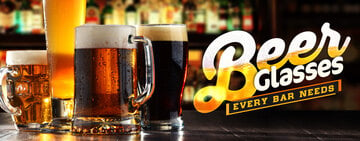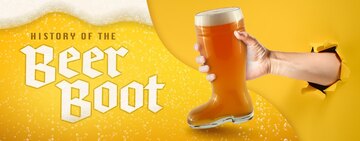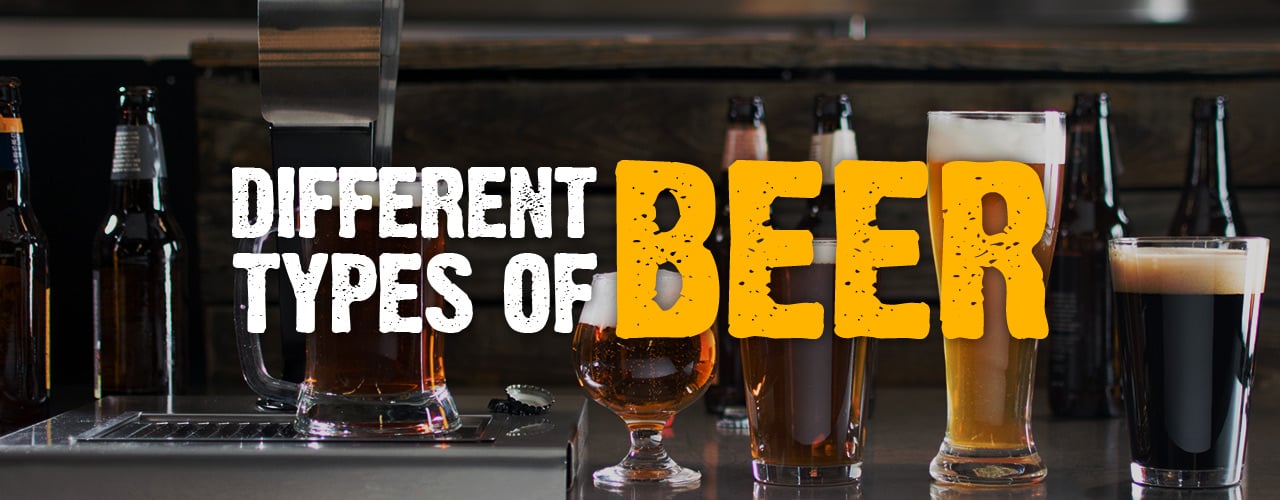
Different Types of Beer
Last updated on 8/1/2022There are over 9,000 craft breweries in the United States, proving that craft beer is bigger than ever. If you're interested in opening a bar or starting your own brewery, it's important to understand the different types of beer and their unique flavors. We break down the most popular beer types so you can talk about craft beer like a pro, make recommendations, and brew your own styles.
Shop All Brewery EquipmentTypes of Beer Video
Watch our video below as we go over the different types of beer.
Types of Beer
Here are some of the most common types of beer you'll encounter:
- Pale Lager and Pilsner
- Dark Lager
- Brown Ale
- Pale Ale
- India Pale Ale
- Porter
- Stout
- Belgian-Style Ale
- Wheat Beer
- Wild & Sour Ale
- Specialty Beer
Beer Styles
The types of beer can be broken down into hundreds of different styles, all with unique flavors, colors, and aromas. Two characteristics that are used to describe styles of beer are alcohol by volume (ABV) and international bitterness unit (IBU).
What Is ABV?
ABV stands for alcohol by volume and represents the percentage of alcohol in the beer. The amount of alcohol in the brew can actually affect the taste of the beer. Beers with a higher ABV have a more bitter flavor. In very strong beers, the alcohol can numb the tongue and neutralize the taste, so additional flavors are added to compensate. Brewers use ABV to achieve the perfect balance between sweetness and bitterness.
What Is IBU?
IBU stands for international bitterness unit and is a measurement of the number of bitter flavor compounds in a beer. The IBU scale starts at zero and has no upper limit, but most beers fall between 5 IBUs and 120 IBUs. Anything higher than 120 can't be detected by the average palate.
Types of Beer List
Below, we identify the different types of beer and offer tips for food pairings. Don't forget to choose the right beer glass for each style so you can enhance the drinking experience for your guests:
Types of Pale Lagers and Pilsners
Pale lager and pilsners are golden-colored beers that are light in flavor and low in alcohol content. This style of beer became popular in what is now modern Czech Republic and Germany.
American Lager
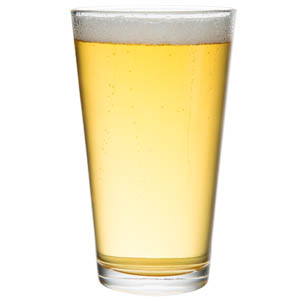
American lager is light in flavor, color, and alcohol content, and it's often produced in large quantities.
- ABV: 3.2-4.0%
- IBU: 5-15
- Examples: Budweiser, Coors, Pabst Blue Ribbon
- Pairs With: American cuisine, spicy food
- Serving Temperature: 30-40 degrees Fahrenheit
German Helles

German helles is maltier than a traditional pilsner and features a bright gold color.
- ABV: 4.8-5.6%
- IBU: 18-25
- Examples: Victory Helles Lager, Stoudt's Gold Lager
- Pairs With: German cuisine, pork, brie
- Serving Temperature: 40-45 degrees Fahrenheit
German Pilsner

German pilsner is pale gold in color with a medium hop flavor and a slight note of maltiness.
- ABV: 4.6-5.3%
- IBU: 25-40
- Examples: Troegs Sunshine Pils, Sierra Nevada's Nooner Pilsner
- Pairs With: German cuisine, poultry, fish, spicy cheese
- Serving Temperature: 40-45 degrees Fahrenheit
- ABV: 4.1-5.1%
- IBU: 30-45
- Examples: Lagunitas PILS, Dogfish Head Piercing Pils
- Pairs With: Spicy food, Asian cuisine, sharp cheddar cheese
- Serving Temperature: 40-45 degrees Fahrenheit
- ABV: 4.8-5.4%
- IBU: 18-30
- Examples: Yuengling Lager, Samuel Adams Boston Lager
- Pairs With: American cuisine, poultry, beef, cheddar
- Serving Temperature: 45-50 degrees Fahrenheit
- ABV: 5.1-6.0%
- IBU: 18-25
- Examples: Paulaner Oktoberfest-Märzen, Victory Brewing Company Festbier
- Pairs With: German cuisine, meat and vegetables, spicy cheese
- Serving Temperature: 45-50 degrees Fahrenheit
- ABV: 3.8-4.9%
- IBU: 22-30
- Examples: Shiner Bohemian Black Lager, Guinness Black Lager
- Pairs With: German cuisine, spicy food, muenster cheese
- Serving Temperature: 40-45 degrees Fahrenheit
- ABV: 4.5-5.5%
- IBU: 22-28
- Examples: Dos Equis Amber Lager, Great Lakes Eliot Ness, Blue Point Toasted Lager
- Pairs With: German cuisine, Mexican cuisine, pork, spicy cheese
- Serving Temperature: 40-45 degrees Fahrenheit
- ABV: 6.3-7.5%
- IBU: 20-30
- Examples: Samuel Adams Winter Lager, Great Lakes Rockefeller Bock
- Pairs With: German cuisine, meat and vegetables, chocolate, Camembert cheese
- Serving Temperature: 40-45 degrees Fahrenheit
- ABV: 6.6-7.9%
- IBU: 17-27
- Examples: Troegs Troegenator Double Bock, Samuel Adams Double Bock
- Pairs With: Heavy foods like red meat, pork, or ham, sharp cheeses
- Serving Temperature: 40-45 degrees Fahrenheit
- ABV: 7.0-9.5%
- IBU: 15-35
- Examples: Victory Brewing Company's Moonglow, Southern Tier Brewing Company's Goat Boy
- Pairs With: German cuisine, poultry, chocolate
- Serving Temperature: 40-45 degrees Fahrenheit
- ABV: 6.0-8.0%
- IBU: 20-38
- Examples: Capital Maibock, Hofbrau Maibock, Smuttynose Maibock
- Pairs With: Italian and German cuisines, fish, shellfish, asiago, Swiss cheese
- Serving Temperature: 45-50 degrees Fahrenheit
- ABV: 4.2-6.3%
- IBU: 25-45
- Examples: Brooklyn Brown Ale, Sierra Nevada Tumbler Autumn Brown
- Pairs With: American cuisine, heavy foods like beef stew, red meat
- Serving Temperature: 45-50 degrees Fahrenheit
- ABV: 4.0-5.5%
- IBU: 15-25
- Examples: Newcastle Brown Ale, City Star Brewing's Bandit Brown
- Pairs With: American cuisine, heavy foods, red meat, poultry, gouda cheese
- Serving Temperature: 40-45 degrees Fahrenheit
- ABV: 4.4-6.1%
- IBU: 25-45
- Examples: Lagunitas Imperial Red Ale, Stone Brewing Company's Levitation Ale
- Pairs With: American cuisine, meat, fish, blue cheese
- Serving Temperature: 40-45 degrees Fahrenheit
- ABV: 4.4-5.4%
- IBU: 30-50
- Examples: Sierra Nevada Brewing Company's Pale Ale, Smuttynose Shoals Pale Ale
- Pairs With:Seafood, poultry, cheddar cheese
- Serving Temperature: 40-45 degrees Fahrenheit
- ABV: 4.1-5.1%
- IBU: 15-25
- Examples: Victory Brewing Company's Summer Love, Flying Fish Brewing Company's Farmhouse Summer Ale
- Pairs With: Italian cuisine, spicy food, fish, pepper jack cheese
- Serving Temperature: 35-40 degrees Fahrenheit
- ABV: 3.0-4.2%
- IBU: 20-35
- Examples: Sharp's Brewery's Doom Bar Bitter, Surly Brewing Company's Bitter Brewer
- Pairs With: Fried food, fish, feta cheese
- Serving Temperature: 45-50 degrees Fahrenheit
- ABV: 4.5-5.5%
- IBU: 20-40
- Examples: Black Sheep Ale, Flying Fish Extra Pale Ale
- Pairs With: American and English cuisines, meat, English cheeses
- Serving Temperature: 40-45 degrees Fahrenheit
- ABV: 6.3-7.5%
- IBU: 50-70
- Examples: Dogfish Head 60 Minute IPA, Sierra Nevada Torpedo Extra IPA
- Pairs With: American and Indian cuisines, meat, poultry, fish, gorgonzola cheese
- Serving Temperature: 40-45 degrees Fahrenheit
- ABV: 7.0-14.0%
- IBU: 65-100
- Examples: Russian River Brewing Company's Pliny the Elder, Lagunitas Maximus
- Pairs With: American cuisine, meat, fish, sharp cheddar
- Serving Temperature: 45-50 degrees Fahrenheit
- ABV: 5.0-7.0%
- IBU: 35-63
- Examples: Goose Island India Pale Ale, Shipyard IPA, Samuel Smith’s India Ale
- Pairs With: American and Indian cuisines, fish, parmesan cheese
- Serving Temperature: 40-45 degrees Fahrenheit
- ABV: 7.0-12.0%
- IBU: 35-50
- Examples: Sierra Nevada Brewing Company's Porter, Stone Smoked Porter
- Pairs With: American cuisine, barbecue, meat, asiago cheese
- Serving Temperature: 40-45 degrees Fahrenheit
- ABV: 4.5-6.0%
- IBU: 20-30
- Examples: Shipyard Longfellow Winter Ale, Arcadia London Porter
- Pairs With: American and English cuisines, meat, chocolate, fontina cheese
- Serving Temperature: 50-55 degrees Fahrenheit
- ABV: 5.1-6.6%
- IBU: 25-40
- Examples: Smuttynose Robust Porter, Thomas Hooker Imperial Porter
- Pairs With: American and English cuisines, heavy foods like stew, colby cheese
- Serving Temperature: 40-45 degrees Fahrenheit
- ABV: 5.7-8.9%
- IBU: 35-60
- Examples: Highland Black Mocha Stout, Bell's Kalamazoo Stout
- Pairs With: Heavy foods, meat, oysters, chocolate, brie cheese
- Serving Temperature: 45-50 degrees Fahrenheit
- ABV: 7.0-12.0%
- IBU: 50-80 F
- Examples: Dogfish Head Brewery's Worldwide Stout, Stoudt's Fat Dog Imperial Stout, Bell's Java Stout
- Pairs With: Heavy foods, poultry, aged cheddar
- Serving Temperature: 45-50 degrees Fahrenheit
- ABV: 3.8-6.0%
- IBU: 20-40
- Examples: Young's Oatmeal Stout, Troegs Java Head Stout
- Pairs With: Meat, shellfish, chocolate, Camembert cheese
- Serving Temperature: 50-55 degrees Fahrenheit
- ABV: 4.0-7.0%
- IBU: 15-25
- Examples: Young's Double Chocolate Stout, Lancaster Brewing Company's Milk Stout, Samuel Adams Cream Stout
- Pairs With: Mexican cuisine, beef, chocolate, ice cream, cheddar
- Serving Temperature: 50-55 degrees Fahrenheit
- ABV: 3.8-5.0%
- IBU: 30-40
- Examples: Guinness Draught, Murphy's Irish Stout, Beamish Irish Stout
- Pairs With: Heavy food like beef and stew, barbecue, burgers
- Serving Temperature: 45-50 degrees Fahrenheit
- ABV: 4.0-6.0%
- IBU: 20-30
- Examples: Weyerbacher Brewing Company's Verboten, Samuel Adams Belgian Session
- Pairs With: American cuisine, fried food, fish, salad, tangy cheeses
- Serving Temperature: 45-50 degrees Fahrenheit
- ABV: 6.3-7.6%
- IBU: 20-35
- Examples: Chimay Premiere, Blue Moon Winter Abbey Ale, Flying Fish Abbey Dubbel
- Pairs With: American cuisine, barbecue, meat, Limburger cheese
- Serving Temperature: 50-55 degrees Fahrenheit
- ABV: 7.1-10.1%
- IBU: 20-45
- Examples: Victory Golden Monkey, Weyerbacher Merry Monks
- Pairs With: Pasta dishes, meat, poultry, gouda cheese
- Serving Temperature: 45-50 degrees Fahrenheit
- ABV: 7.2-11.2%
- IBU: 25-50
- Examples: Weyerbacher QUAD, Brewery Ommegang Three Philosophers
- Pairs With: Smoked meat, goose, brie cheese
- Serving Temperature: 50-55 degrees Fahrenheit
- ABV: 7.0-15.0%
- IBU: 20-50
- Examples: Bell's Brewery's Hell Hath No Fury Ale, Dogfish Head Brewery's Raison D'Etre
- Pairs With: American cuisine, barbecue, blue cheese
- Serving Temperature: 45-50 degrees Fahrenheit
- ABV: 4.4-6.8%
- IBU: 20-38
- Examples: Samuel Adams Rustic Saison, Dogfish Head Brewery's Noble Rot, Victory Brewing Company's Helios
- Pairs With: Indian and Asian cuisine, poultry, seafood, parmesan cheese
- Serving Temperature: 45-50 degrees Fahrenheit
- ABV: 3.5-5.6%
- IBU: 10-35
- Examples: Blue Moon Summer Honey Wheat, Shipyard Summer Ale
- Pairs With: Mexican cuisine, spicy food, poultry, mozzarella cheese
- Serving Temperature: 45-50 degrees Fahrenheit
- ABV: 4.8-5.6%
- IBU: 10-17
- Examples: Hoegaarden White Ale, Dogfish Head Brewery's Namaste, Blue Moon Belgian White, Victory Brewing Company's Whirlwind Witbier
- Pairs With: Seafood, poultry, pork, salad, soft cheeses
- Serving Temperature: 45-50 degrees Fahrenheit
- ABV: 2.8-3.4%
- IBU: 3-6
- Examples: Dogfish Head's Festina Peche, Freetail Brewing Company's Yo Soy Un Berliner
- Pairs With: German cuisine, ham, salad, soft cheeses
- Serving Temperature: 45-50 degrees Fahrenheit
- ABV: 4.8-5.4%
- IBU: 10-15
- Examples: Samuel Adams Dunkelweizen, Franziskaner Hefe-Weisse Dunkel
- Pairs With: German and Indian cuisines, fish, goat cheese
- Serving Temperature: 40-45 degrees Fahrenheit
- ABV: 4.9-5.6%
- IBU: 10-15
- Examples: Sierra Nevada Kellerweis Hefeweizen, Magic Hat Circus Boy
- Pairs With: German cuisine, seafood, fish, brick cheeses
- Serving Temperature: 45-50 degrees Fahrenheit
- ABV: Varies
- IBU: Varies
- Examples: Samuel Adams American Kriek, Weyerbacher Riserva
- Pairs With: Fruit, strong cheese
- Serving Temperature: 45-50 degrees Fahrenheit
- ABV: 5.0-8.9%
- IBU: 15-21
- Examples: Upland Brewing Company's Raspberry Lambic, Dogfish Head Festina Lente
- Pairs With: Fruit, salad, chocolate, soft cheese
- Serving Temperature: 45-50 degrees Fahrenheit
- ABV: 4.8-6.6%
- IBU: 5-18
- Examples: New Belgium Lips of Faith La Folie, The Lost Abbey's Red Poppy Ale
- Pairs With: Meat, blue cheese, cheddar cheese
- Serving Temperature: 45-50 degrees Fahrenheit
- ABV: 6.2-8.1%
- IBU: 9-23
- Examples: Brouwerij Boon's Boon Gueuze, The Bruery's Rueuze
- Pairs With: Strong cheeses
- Serving Temperature: 50-55 degrees Fahrenheit
- ABV: 6.0-7.5%
- IBU: 50-75
- Examples: Lagunitas NightTime, Founders Dark Penance, Victory Yakima Glory
- Pairs With: Aged cheeses, seafood, chocolate
- Serving Temperature: 50-55 degrees Fahrenheit
- ABV: Varies
- IBU: Varies
- Examples: Allagash Curieux (Bourbon Barrel-Aged Tripel), Great Lakes Barrel-Aged Blackout Stout, Narwhal Imperial Stout (Barrel Aged)
- Pairs With: Varies
- Serving Temperature: 50-55 degrees Fahrenheit
- ABV: 2.5-12.0%
- IBU: 15-40
- Examples: Samuel Adams Chocolate Bock, Shenandoah Chocolate Donut Beer, Yuengling Hershey's Chocolate Porter
- Pairs With: Varies
- Serving Temperature: 50-55 degrees Fahrenheit
- ABV: 2.5-12.0%
- IBU: 15-45
- Examples: Samuel Adams Black & Brew Coffee Stout, Sierra Nevada Coffee Stout, Stone Brewing Company’s Coffee Milk Stout
- Pairs With: Meaty stew, hard cheeses
- Serving Temperature: 50-55 degrees Fahrenheit
- ABV: 2.5-12.0%
- IBU: 5-50
- Examples: Samuel Adams Rebel Grapefruit IPA, Modern Times Beer’s Fruitlands Sour Cherry Gose, Weyerbacher’s Imperial Pumpkin Ale
- Pairs With: Salad, brie cheese
- Serving Temperature: 50-55 degrees Fahrenheit
- ABV: Varies
- IBU: Varies
- Examples: Wicked Weed Brewing’s Gluten FREEk, Widmer Brothers Brewing Company’s Omission IPA, Lakefront Brewery’s New Grist Gluten-Free Pilsner
- Pairs With: Varies
- Serving Temperature: Varies
- ABV: 2.5-12.0%
- IBU: 5-40
- Examples: Dogfish Head’s Midas Touch, Rogue Ales’ Juniper Pale Ale, Small Town Brewery’s Not Your Father’s Root Beer
- Pairs With: Varies
- Serving Temperature: 45-55 degrees Fahrenheit
- ABV: 2.5-12.0%
- IBU: Varies
- Examples: Boulder Beer’s A Honey of a Saison, Samuel Adams Honey Queen, Burial Beer Company’s The Keeper’s Veil Honey Saison
- Pairs With: Salad, light creamy cheeses
- Serving Temperature: 50-55 degrees Fahrenheit
- ABV: 2.3-5.0%
- IBU: 5-70
- Examples: Elysian Brewing Company’s Night Owl Pumpkin Ale, Weyerbacher Brewing Company’s Imperial Pumpkin Ale, Samuel Adams Harvest Pumpkin Ale, Smuttynose Pumpkin Ale
- Pairs With: Poultry, soft creamy cheeses
- Serving Temperature: 50-55 degrees Fahrenheit
- ABV: Varies
- IBU: Varies
- Examples: Founders Red’s Rye IPA, Great Lakes’ Rye of the Tiger IPA, The Bruery’s Sour in the Rye
- Pairs With: Spicy meat, creamy cheeses
- Serving Temperature: 45-55 degrees Fahrenheit
- ABV: 3.5-5.0%
- IBU: 10-35
- Examples: New Belgium Brewing’s Slow Ride Session IPA, Samuel Adams Rebel Rider Session IPA, Victory Brewing Company’s Swing Session Saison
- Pairs With: American cuisine, spicy food
- Serving Temperature: 30-40 degrees Fahrenheit
- ABV: Varies
- IBU: Varies
- Examples: Ithaca Beer Company's Gorges Smoked Porter, Goose Island Beer Company’s Prairie Smoke, Denver Beer Company’s Smoked Lager
- Pairs With: Roasted vegetables, hard cheese
- Serving Temperature: 30-40 degrees Fahrenheit
Czech or Bohemian Pilsner
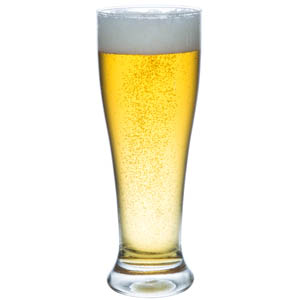
Czech or bohemian pilsner is a straw-colored beer with a noticeably bitter hop flavor. These beers can sometimes have a floral aroma.
Back to Top
Types of Dark Lagers
Dark lager is malty and smooth with toasted caramel flavors. These beers tend to have mid-range alcohol content and lower bitterness profiles.
Amber American Lager

Amber lager features prevalent malt flavors with varying levels of hoppiness. This beer is also characterized by a darker color, caramel aroma, and smooth taste.
Oktoberfest

Named for the Oktoberfest celebration in Munich, Oktoberfest is a full-bodied beer with a rich, toasted flavor and a dark copper color.
German Schwarzbier
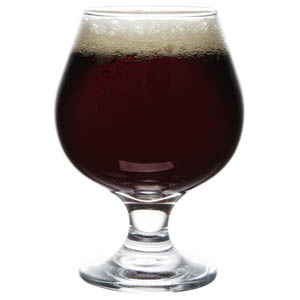
Schwarzbier is a dark beer that is surprisingly light in flavor. Schwarzbiers are less malty than would be expected but still boast a slight sweetness.
Vienna Lager
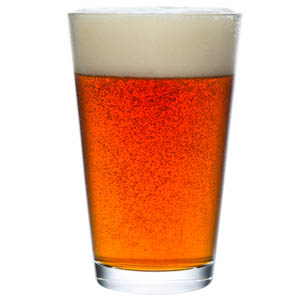
Vienna lager is reddish in color with a sweet malty flavor. These beers boast a subtle hop flavor and crisp drinkability.
Back to Top
Types of German Bocks
German bocks are heavy on malty flavor, making them sweet and nutty. Bocks have lower alcohol levels, while doppelbocks, weizenbocks, and maibocks move up the alcohol scale.
Traditional Bock
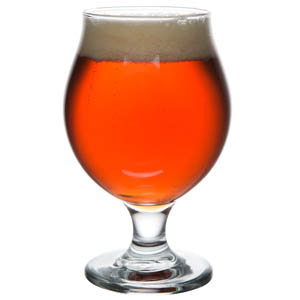
The bock is a malty, sweet beer with a toasty flavor and a dark copper color.
Doppelbock

Doppelbocks are stronger than the traditional style and boast a higher alcohol content and a fuller body.
Weizenbock
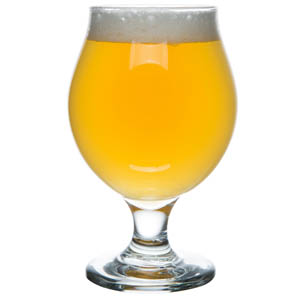
Weizenbocks are wheat bocks and can take on fruity, malty flavors.
Maibock

Maibocks are more pale and hoppy than traditional bocks, although the malt flavor is still present.
Back to Top
Types of Brown Ales
Brown ales feature malty overtones and tend to have toasty, caramel flavors. They typically feature mid-range alcohol content and hop bitterness.
American Brown Ale

American brown ale is a dark beer without the bitterness of porters and stouts. This style boasts a dark caramel color and a medium to full-bodied profile.
English Brown Ale
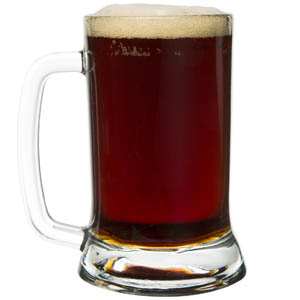
English brown ale features a nutty malt flavor with a caramel aroma.
Back to Top
Types of Pale Ales
Pale ales are generally hoppy but lower in alcohol content than IPAs. They are typically light, drinkable beers.
American Amber Ale
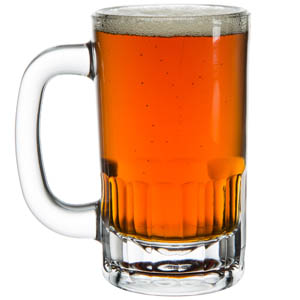
American amber ale is a malty, medium-bodied beer with a caramel flavor and amber color.
American Pale Ale

American pale ale is a medium-bodied beer with a noticeable hop flavor and a light copper color.
Blonde Ale

Blonde ales balance the flavors of malt and hops nicely, and they often have a fruity aroma.
English Bitter
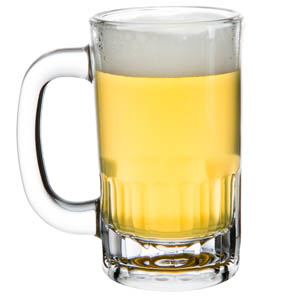
English bitters are named for the bitter flavor that the hops present. They have fruity flavors and lower alcohol content.
English Pale Ale
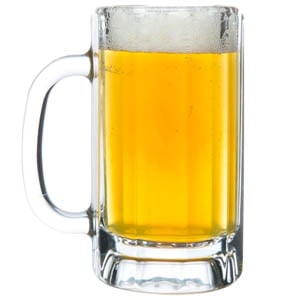
Also known as "extra special bitters," English pale ales have a strong hop flavor that is balanced by sweet malt.
Back to Top
Types of India Pale Ales (IPAs)
IPAs (short for India pale ales) boast strong hop bitterness with piney and floral flavors. These beers also have high alcohol contents.
American IPA
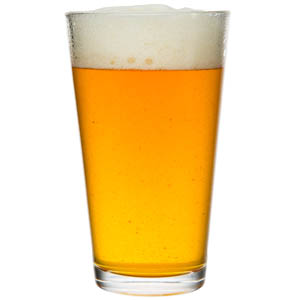
American IPAs have more hops, big herbal or citrus flavors, and high bitterness compared to pale ale.
Imperial or Double IPA
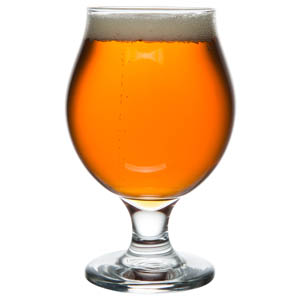
Imperial or Double IPAs are American IPAs, but with a stronger flavor, hop bitterness, and a higher alcohol content.
English IPA

English IPAs are similar to the American style, but with a weaker hop flavor and lower alcohol content.
Back to Top
Types of Porters
Porters are all dark in color, and they feature flavors reminiscent of chocolate, coffee, and caramel. They tend to be more chocolatey than brown ales, and less coffee-like than stouts.
American Imperial Porter

American imperial porters are dark in color, but lacking in burnt malt taste. They also boast a malty sweetness.
English Brown Porter
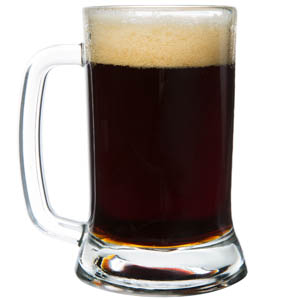
English brown porter is similar to the American style but usually with a lower alcohol content and less malt sweetness.
Robust Porter
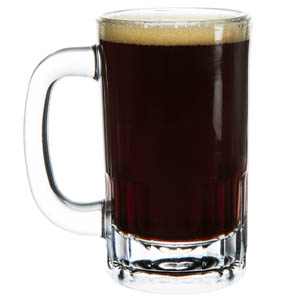
Robust porters are stronger and more bitter than a brown porter and feature a subtle caramel flavor.
Back to Top
Types of Stouts
Stouts are dark beers that are similar to porters but with stronger roasted flavors. This style also features mid to high alcohol levels.
American Stout
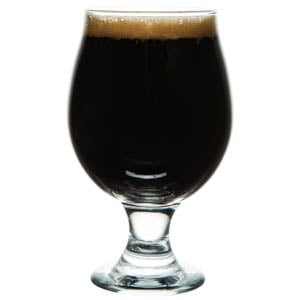
American stouts feature malt flavors working to create strong chocolate and coffee notes, but without overpowering hop bitterness.
American Imperial Stout
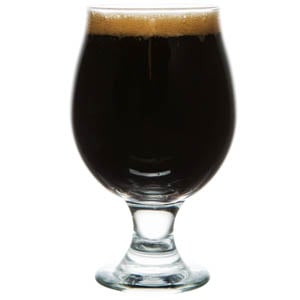
American imperial stouts are strong dark beers with a malty flavor and a deep black color.
Oatmeal Stout
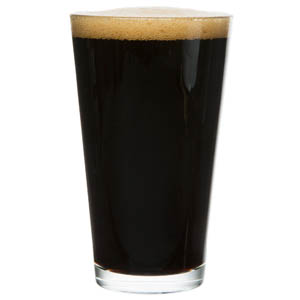
As their name suggests, oatmeal stouts feature oatmeal in their malt blend. This adds smoothness and sweetness to the beer.
Milk Stout
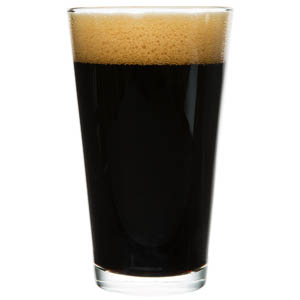
Lactose sugar adds a smooth sweetness to milk stouts.
Irish Dry Stout

Irish dry stouts are dark beers; black in color with a bitterness that comes from roasted barley.
Back to Top
Types of Belgian Styles
Belgian beers are known for their spiced fruity flavors and high alcohol content. Despite their high ABV, belgians are usually low in bitterness.
Belgian Pale Ale

Belgian pale ale contains a toasted malt flavor that is subtle enough to not overpower the taste of the hops.
Belgian Dubbel
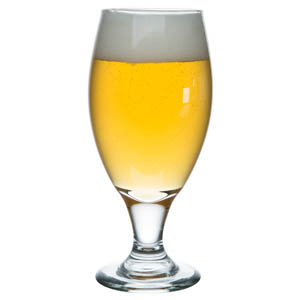
Belgian dubbels feature rich and malty flavor with a spicy, fruity note.
Belgian Tripel

Belgian tripels are lighter-bodied beers with a slight hoppy bitterness and a high alcohol content.
Belgian Quadrupel

Belgian quadrupels are dark brown, full-bodied beers that exhibit flavors like brown sugar and fruit. They also have a very high alcohol content.
Belgian Strong Dark Ale
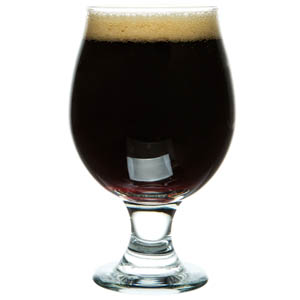
Belgian strong dark ale features a very high alcohol content with complex fruity flavors.
Belgian Saison

Saisons (also known as farmhouse ales) have earthy notes and a medium hop flavor.
Back to Top
Types of Wheat Beers
As you might have guessed, wheat beers use wheat as their malt. They're generally lighter in color and alcohol content. Their tangy flavors go great with fruit and brewers often add seasonal fruits to wheat beer.
American Pale Wheat
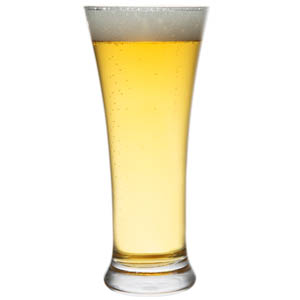
American pale wheat beer is pale in color, lower in alcohol content, and has a light bready flavor.
Belgian Witbier
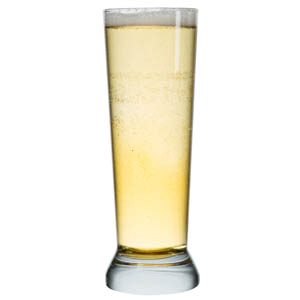
Witbier gets its name from its white color and has a light, fruity flavor to match.
Berliner Weisse

Berliner Weisse is tart, sour beer with a pale color. Sometimes raspberry syrup is added to dull the sour taste.
Dunkelweizen
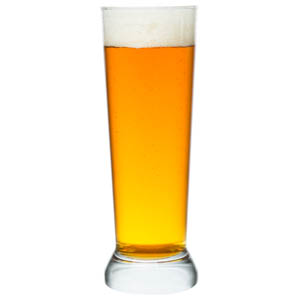
Dunkelweizen is a darker version of a Hefeweizen. These beers have a malty flavor with hints of banana.
Hefeweizen
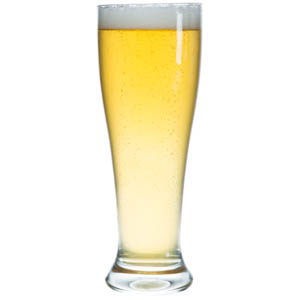
Hefeweizen is a light-colored wheat beer with a crisp taste that can sometimes have hints of cloves or apples.
Back to Top
Types of Wild & Sour Ales
Wild or sour ales are typically very low in alcohol, and feature tart, sour flavors that come from (safe) bacteria in the brew mash.
American Sour

American sour beer packs a wild punch from the bacteria used in the fermentation process.
Belgian Fruit Lambic
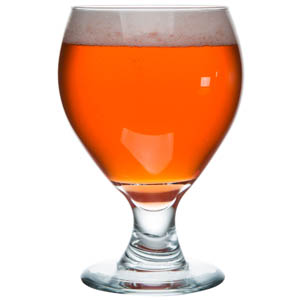
Belgian fruit lambics are brewed with fruit to make an intense sweet and sour flavor.
Flanders Red Ale
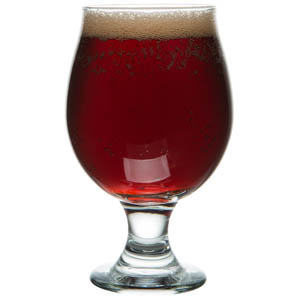
Flanders red ale evokes a malty, fruity flavor underneath a strong sour taste brought on by Lactobacillus bacteria during fermentation.
Belgian Gueuze
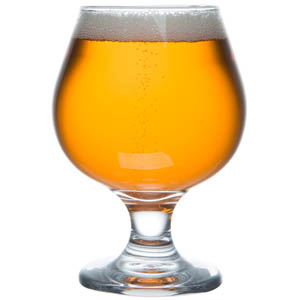
Gueuzes are aged beers that give off a very strong sour flavor.
Back to Top
Types of Specialty Beers
Beers made with additional spices, flavorings, or fruits are called specialty beers. Any lager or ale can be made into a specialty beer by adding ingredients to enhance the flavor.
American Black Ale
American black ales are dark in color and feature a malty, roasted flavor with medium to high hop bitterness. This style is sometimes called a black IPA.
Barrel-Aged Beer
A barrel-aged beer is any type of beer that has been aged in a wooden barrel. Sometimes these barrels have been used to hold bourbon, wine, or other spirits, adding to the flavor of the beer.
Chocolate Beer
Chocolate or cocoa can be added to any style (lager or ale) to form a delicious chocolate beer.
Coffee Beer
Coffee beer is typically a porter or stout with added coffee flavor. This flavor can be achieved by steeping coffee beans in water or the beer mixture.
Fruit and Vegetable Beer
Any type of beer can be infused with fruit and vegetable flavors, so flavors will vary greatly.
Gluten Free Beer
Gluten free beer is brewed with fermentable sugars and grains that do not contain gluten. These beers vary in color, flavor, and alcohol content.
Herb and Spice Beer
Herb and spice beer is any lager or ale that has added flavors from roots, herbs, or other spices. Many pumpkin spice and seasonal fall beers are examples of this style.
Honey Beer
Honey beers are ales or lagers that are brewed with honey to add sweetness and unique flavor.
Pumpkin Beer
Pumpkin beer is brewed with fresh pumpkin and common fall spices. These beers are increasingly popular and can be made with lagers, ales, and sour beers.
Rye Beer
Rye beer often features malty, roasted flavors, with lower hop bitterness. Rye beers can be made as ales or as lagers, and will either take on a sweet or spicy flavor.
Session Beer
Any style of beer can be brewed as a session beer, as sessions are simply less strong, more drinkable beers that are perfect for summertime consumption.
Smoke Beer
Smoke beer is any beer that is brewed with malt that has been kilned over an open fire. The smoke adds a noticeable, but not overpowering flavor, which is inspired by traditional German rauchbier.
Back to Top
Lager vs Ale
Most types of beer are classified as either lagers or ales. Lagers are made with yeast that ferments at the bottom of the beer mixture, and ales are made with yeast that ferments at the top. Besides the yeast used to make lagers and ales, there are spontaneously fermenting yeasts, which produce wild or sour beers.
Pale Ale vs India Pale Ale
Although often confused with each other, pale ales and India pale ales have some distinct differences. Pale ales tend to have a softer less-bitter taste, while India pale ales usually have a strong hoppy taste. Additionally, India pale ales tend to have a slightly higher alcohol content than pale ales do, further contributing to their stronger taste.
Top Fermenting Beers
The yeast that is used in ale production ferments throughout the beer and settles at the top of the liquid. It has a higher tolerance to alcohol and ferments at warmer temperatures when compared to the yeast that’s used to make lager. IPAs, stouts, and wheat beers are all examples of top fermenting ales.
Bottom Fermenting Beers
The yeast used in lager production is more fragile than what’s used to make ale, and it settles at the bottom of the liquid vessel after fermentation. It needs to ferment more slowly and at cooler temperatures than the yeast that’s used in ale production, and it has a lower tolerance to alcohol. Pilsners, bocks, and Okerberfests are all examples of bottom fermenting lagers.
Spontaneous Fermentation Beer
Lambics and sour beers are made with a process called spontaneous fermentation. This type of fermentation occurs when beer is exposed to wild bacteria and yeast. These beers originated in Belgium, but brewers all over the world have found ways to manipulate this process to create sour, funky-tasting beers of their own. The American sour, Belgian gueuze, and Flanders red ale are all examples of spontaneously fermented beers.
Back to TopNow that you know more about the different types of beer that are out there, hopefully you are inspired to add something unique to your beer list. Use this guide to help you and your servers feel more confident about recommending beers to customers, or maybe even create a menu that is centered on perfect beer pairings.

